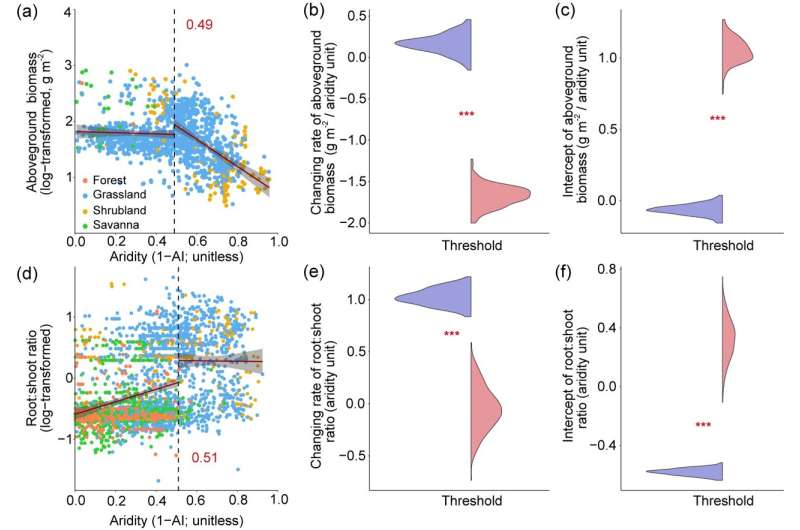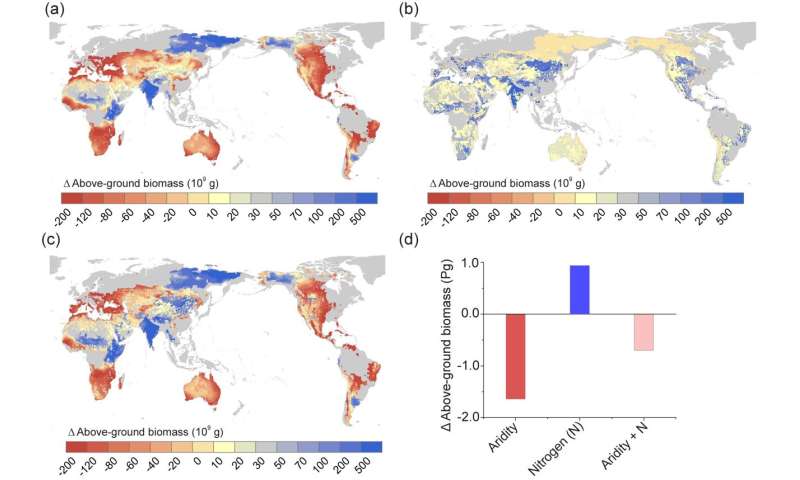
Aridity thresholds for measured (a) aboveground biomass (n=1353) and (d) root-shoot ratio (n=3093). Solid red lines represent the linear fits on both sides of each threshold. The red numbers and vertical dashed lines represent the identified aridity thresholds. Plant biomass data were log-transformed to conform to normality. The violin diagrams in panels b and e show bootstrapped slopes of the predicted fitted trend at the threshold of the two regressions existing at each side of the threshold (purple before the threshold, red after the threshold). The violin diagrams in panels c and f show bootstrapped intercepts. The asterisks represent a significant difference before and after the aridity threshold at p Crossing certain aridity thresholds in global drylands can lead to abrupt decays of ecosystem attributes such as plant productivity, potentially causing land degradation and desertification. It is largely unknown, however, whether these thresholds can be altered by other key global change drivers known to affect the water-use efficiency and productivity of vegetation, such as elevated CO2 and nitrogen (N) enrichment.
This study was led by Dr. Jian-Sheng Ye from Lanzhou University, China. In it, researchers gathered over 5,000 field measurements of plant biomass. Their findings revealed that crossing an aridity threshold of ~0.50, which marks the transition from dry sub-humid to semi-arid climates, led to abrupt declines in aboveground biomass (AGB) and progressive increases in the root: shoot ratios. This has a profound impact on carbon storage and its distribution within these ecosystems.
Notably, N enrichment was found to significantly increase aboveground biomass and delay the onset of the aridity threshold from 0.49 to 0.55. However, increased CO2 levels did not alter the observed aridity threshold.

Measured plant aboveground biomass (a) and comparisons of aridity threshold values (b) under ambient and nitrogen (N) enrichment treatments (n=167 sites). Remotely sensed and random forest model-simulated leaf area index (c), and comparisons of aridity threshold values (d) under high (401 ppm) and low (341 ppm) CO2 levels. The two comparisons are based on paired datasets of high vs. low N/CO2 levels. Data were log-transformed to conform to normality. Box plots in (b) and (d) show the median, upper and lower quartiles, with outlier values represented by black dots. Different letters indicate significant differences in aridity thresholds between high versus low N levels (p
Panels A and B show the frequency distributions of changes in aridity and nitrogen deposition, respectively. Panel C shows predicted future changes in land area crossing the observed aridity threshold; the comparisons between scenarios considering (a, c, e, g, i, k) and not including (b, d, f, h, j, l) the effects of nitrogen deposition are also shown. Credit: Science China Press

Changes in AGB by 2100 under the RCP8.5 scenario due to aridity changes (a), nitrogen deposition (b) and the combination of both (c). The overall changes in AGB are summarized in panel d. We include land areas with aridity ≥ 0, i.e., zones where annual precipitation is ≤ potential evapotranspiration (excluding croplands). Credit: Science China Press
Looking ahead to the year 2100, under a high greenhouse gases emissions scenario, researchers predicted a minor 0.3% net increase in the global land area that surpasses the aridity threshold when considering the effects of N enrichment. In contrast, without factoring in N enrichment, this net increase was projected to reach 2.9%. This suggests that N enrichment can mitigate the negative impacts of rising aridity on plant biomass in drylands.
These findings carry significant implications for our ability to improve forecasts of vegetation responses to change in aridity, nitrogen and CO2. The study is published in the journal National Science Review.
More information:
Hailing Li et al, Nitrogen enrichment delays the emergence of an aridity-induced threshold for plant biomass, National Science Review (2023). DOI: 10.1093/nsr/nwad242
Citation:
Nitrogen enrichment delays the emergence of an aridity-induced threshold for plant biomass (2023, October 16)
retrieved 17 October 2023
from https://phys.org/news/2023-10-nitrogen-enrichment-delays-emergence-aridity-induced.html
This document is subject to copyright. Apart from any fair dealing for the purpose of private study or research, no
part may be reproduced without the written permission. The content is provided for information purposes only.
>>> Read full article>>>
Copyright for syndicated content belongs to the linked Source : Phys.org – https://phys.org/news/2023-10-nitrogen-enrichment-delays-emergence-aridity-induced.html





























